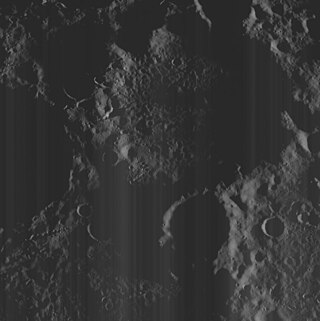
de Gerlache is a lunar impact crater that is located along the southern limb of the Moon, within a crater diameter of Shackleton at the south pole. From the Earth this crater is seen from the edge, and it lies in perpetual darkness. Thus little or no detail can be seen of this crater, other than the edge of the rim. However, the crater is clearly visible in Earth-based radar images. The crater is roughly circular, with some slight wear. No craters of note overlie the rim, although some formations may be attached to the southern and western edges.

Nobile is a lunar impact crater that is located near the southern pole of the Moon. It was named after the Italian aviator and explorer Umberto Nobile by the International Astronomical Union (IAU) in 1994. It lies to the south of the crater Scott, along the western rim of Amundsen. Between Nobile and the southern pole lie the smaller craters Shoemaker and Faustini.

Abu Nuwas is an impact crater on the planet Mercury, 116 kilometers in diameter. It is located at 17.4°N, 20.4°W. It is named after the Arab poet Abu Nuwas, and its name was approved by the International Astronomical Union in 1976. There is small central peak in the center of the floor of Abu Nuwas, and bright features known as hollows are present near the peak.

Yeats is an impact crater on the planet Mercury. The crater is named after William Butler Yeats, an Irish poet and dramatist. The name was adopted by the International Astronomical Union in 1976.

Aristoxenus is an impact crater near the north pole on Mercury. It was named by the IAU in 1979 after the Greek philosopher Aristoxenus.

Matisse is an impact crater on the southern hemisphere of Mercury. Matisse takes its name from the French artist Henri Matisse, and it was named by the IAU in 1976.

Raphael is a crater on Mercury. Its name was adopted by the International Astronomical Union (IAU) in 1976, and is named for the Italian painter Raphael.

Praxiteles is a crater on Mercury. It is one of 110 peak ring basins on Mercury.

Ictinus is a crater on Mercury. Its depth from crater floor to rim is 4.8 km. Its name was adopted by the International Astronomical Union in 1976. Ictinus is named for the Ancient Greek architect Ictinus, who lived in the 5th century BCE.

Li Chʻing-Chao is a crater on Mercury. It has a diameter of 61 kilometers. Its name was adopted by the International Astronomical Union (IAU) in 1976. Li Chʻing-Chao is named for the Chinese poet Li Qingzhao, who lived from 1081 to c. 1141.

Tolkien is one of the northernmost craters on Mercury, located in the Borealis quadrangle at 88.82 N, 211.08 W. It is 50 km in diameter. It was named after the South African born British writer J. R. R. Tolkien. The name was approved by IAU's Working Group for Planetary System Nomenclature on August 6, 2012. Since Tolkien is very close to the north pole, and Mercury has almost no axial tilt, Tolkien receives very little sunlight. S band radar data from the Arecibo Observatory collected between 1999 and 2005 indicates a radar-bright area covers the entire floor of Tolkien, which is probably indicative of a water ice deposit.

Magritte is a crater on Mercury, near the south pole. This crater was likely created by an impact event, as evident by its circular depression. Its name was adopted by the International Astronomical Union in 2012, after the Belgian painter, René Magritte. Magritte is one of several craters on Mercury named after famous artists. Per the Working Group for Planetary System Nomenclature, all Mercury craters are named after an artist who was famous for more than fifty years who has been deceased for more than three years at the time the crater is named.

Roerich is a crater on Mercury, near the south pole. Its name was adopted by the International Astronomical Union in 2013, after the Russian painter Nicholas Roerich.

Petőfi is a crater on Mercury, near the south pole. Its name was adopted by the International Astronomical Union in 2013, after the Hungarian poet Sándor Petőfi, following the official convention of naming craters on Mercury after historically significant artists, musicians, painters, and authors.

Gordimer is a crater on Mercury, near the north pole. Its name was adopted by the International Astronomical Union (IAU) in 2019, after the South African writer Nadine Gordimer.

Sadī is a crater on Mercury. Its name was adopted by the International Astronomical Union (IAU) in 1976, after Persian poet Saadi Shirazi.

L'Engle is a crater on Mercury, located near the south pole. Its name was adopted by the International Astronomical Union (IAU) in 2013, after American author Madeleine L'Engle.

Lovecraft is a crater on Mercury, located near the south pole. Its name was adopted by the International Astronomical Union (IAU) in 2013, after American author Howard Phillips Lovecraft.

Hurley is a crater on Mercury, located near the south pole. Its name was adopted by the International Astronomical Union (IAU) in 2013, after Australian photographer Frank Hurley.



















